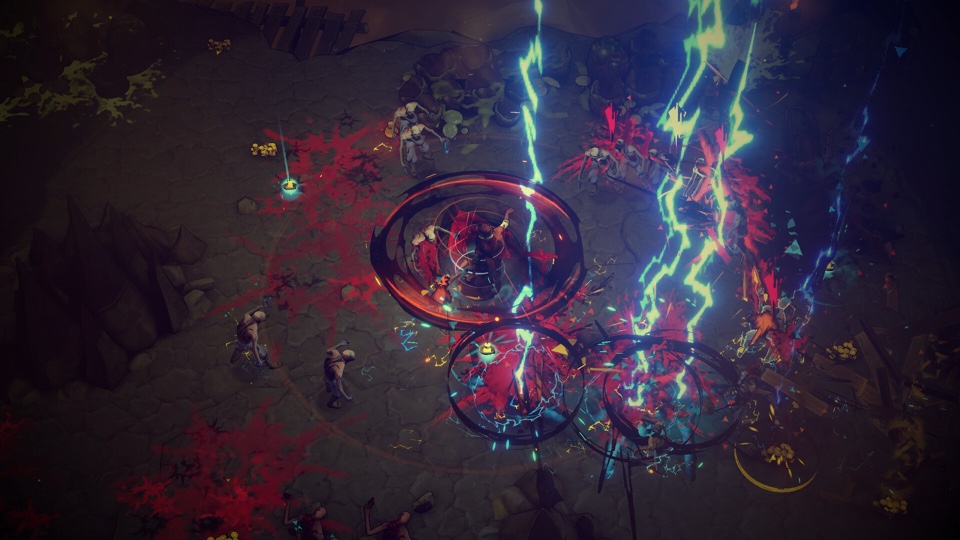Sometimes you can tell how a game will play at a first glance, with the huge explosion of Hades clones generally easy to recognise. I went into my first experience with Hell Clock fully expecting a take on Supergiant’s classic but what I found was actually something far more original and interesting, albeit not without some issues and flaws. While it shares the general rogue-like approach of Zagreus’ adventures, the actual gameplay is far more in keeping with classic Diablo, and scratched a nostalgic itch I didn’t realise I had.
Perhaps the most important aspect of the game is its real historical backdrop, taking place 8 years after Brazil’s War of Canudos, a tragic event in which tens of thousands of refugees were slaughtered by the new Brazilian Republic in the 19th century. This is a historical event about which I was totally unaware before coming across this game and it shows how well games can educate alongside entertain. This is exactly the kind of experience that my erstwhile colleagues are looking at in the forthcoming ‘Playing With History’ book and I’ll be recommending they take a gander at Hell Clock.
This real world context doesn’t mean that the game is hyper realistic, however. Indeed, such is the depth of historical trauma surrounding the War of Canudos that the game’s dark fantasy aesthetic feels like a metaphorical attempt to come to terms with those memories. This is most obviously seen through the monstrous bosses that represent major figures in the invading army. These are truly grotesque and prove extremely challenging until you’ve refined your build.

While the general tone of Hellclock is dark the graphics benefit from an excellent balance of light and shade. A cel-shaded comic book effect helps enemies and backgrounds to stand out and there is a decent range of environments across the various stages – although the layouts themselves tend to repeat relatively quickly. Depending on your choice of skills and powers there can be a vast amount of visual effects on display soon and this can be both a blessing and a curse. Fully powered up attacks look incredible but can bring the framerate crashing down – particularly in the last main area of the game.
Performance as a whole here was decent until that last area (one that I won’t spoil here) where the solid 75fps gradually dropped until it fell off a cliff. The one time I beat the final boss was a battle of attrition with 5fps and took fully 35-40 minutes whilst watching a YouTube video. This is not what the game is intended to play as though and says a lot about my general stubbornness and desire to see the ending for this review.

In fact, the main loop of Hellclock is all about speed and min-maxing your builds. The standard mechanics include the titular Hellclock which constantly counts down towards your death – only pausing during boss battles. At first you have a measly 7 minutes but there are upgrades to unlock that increase this and bosses also drop extra time pick-ups when defeated. This mechanic ensures that every run is a test of your dps rather than skill which clearly appeals to the Path of Exile and Diablo players but is a far cry from the Hades style I was expecting.
There is an option to disable the clock and play the game in a more strategic way but after completing the game this way I would advise against it. While this mode does prevent the constant time pressure it ends up becoming a war of extreme attrition and the resultant drawn-out kiting of damage-sponge enemies can quickly sap your enjoyment. I would go so far as to suggest that the devs should probably remove this option and stick to their preferred approach.

Playing as a resurrected victim of the massacre, you’re armed with a revolver that serves as your primary weapon. I was a little disappointed that there are no alternatives here (rifles, shotguns, or sabres could have mixed things up build-wise) but you can level it up and apply buffs through equipped relics to increase your damage. Basic shots are free but all other attacks require mana to activate so there is a balance to be drawn between attacking and allowing your mana to recharge. The real build strategy comes in choosing from a wide range of spells to add to your arsenal.
These skills range from support effects such as dash and shield to more offensive abilities such as rapid fire and high damage explosives and all are well designed to fit in with the general aesthetic. Each set of skills is unlocked as you progress through the game’s acts but some of the early skills remain useful right up to the end. I found a combination of magical crosses that surrounded my character and life steal from equipped relics was overpowered as it meant I survived far longer than my damage output should have allowed but I think this has been balanced in part through patches (and of course would not have helped with the Hellclock in play).




This review of Hell Clock sounds intriguing! It’s interesting to see how games can explore deeper themes like trauma while incorporating familiar gameplay elements. Looking forward to hearing more about your experience with it!
Absolutely, it’s fascinating how games like Hell Clock can dive into themes of trauma while still engaging players with dynamic gameplay. The blend of intense action and emotional storytelling can really set a game apart and create a lasting impact.
I completely agree! It’s impressive how Hell Clock balances intense gameplay with deeper emotional narratives. This blend can really enhance the player’s experience, making them reflect on their own challenges while enjoying the action.
Absolutely! The way Hell Clock intertwines its fast-paced action with themes of trauma really adds an extra layer to the experience. It’s fascinating to see how games can explore complex emotions while still providing engaging mechanics.
great depth to the gameplay. It’s interesting how the mechanics not only challenge players but also reflect the emotional struggles the characters face. This combination could really resonate with those who appreciate narrative-driven games alongside engaging action.
expand on the themes of trauma and resilience. The way the game intertwines its mechanics with the narrative really enhances the emotional experience, making each challenge feel more significant. It’s impressive how gameplay can reflect deeper issues!
I totally agree! The way the game uses its mechanics to reflect trauma and resilience adds depth to the experience. It’s interesting how the character’s growth mirrors the player’s journey through challenging gameplay, making each victory feel even more rewarding. This connection really enhances the emotional impact of the story.
Absolutely! It’s fascinating how the game’s visuals and soundtrack also enhance that emotional experience. It really draws players into the narrative and makes them reflect on their own journeys.
I completely agree! The combination of visuals and soundtrack really sets the tone for the experience. It’s interesting to see how the game’s mechanics also reflect the themes of trauma, making each challenge feel deeply personal.
Absolutely! The way the art style enhances the storytelling is impressive, and it really immerses players in the themes of trauma and resilience. It’s fascinating how games can evoke such deep emotions through their design elements.
I completely agree! The art style definitely adds depth to the narrative. It’s interesting how the game’s mechanics also reflect the themes of trauma, making each encounter feel more impactful.
Absolutely! The art style really enhances the emotional impact of the story. It’s fascinating how visuals can shape our perception of trauma in games, making the experience even more immersive.
I completely agree! The art style does a fantastic job of immersing players in the game’s atmosphere. Additionally, the use of color and shadow seems to reflect the protagonist’s inner turmoil, which adds another layer to the experience.
Absolutely! The art style really enhances the storytelling, drawing players deeper into the emotional themes of trauma. It’s interesting how visuals can convey so much without words, making the gameplay experience even more impactful.
I completely agree! The art style does an incredible job of immersing players in the game’s atmosphere. Plus, the way it contrasts with the gameplay mechanics adds an interesting layer to how we process the themes of trauma throughout the experience.
Absolutely! The art style really enhances the storytelling, making the themes of trauma more impactful. It’s fascinating how visuals can convey emotions that words sometimes can’t.